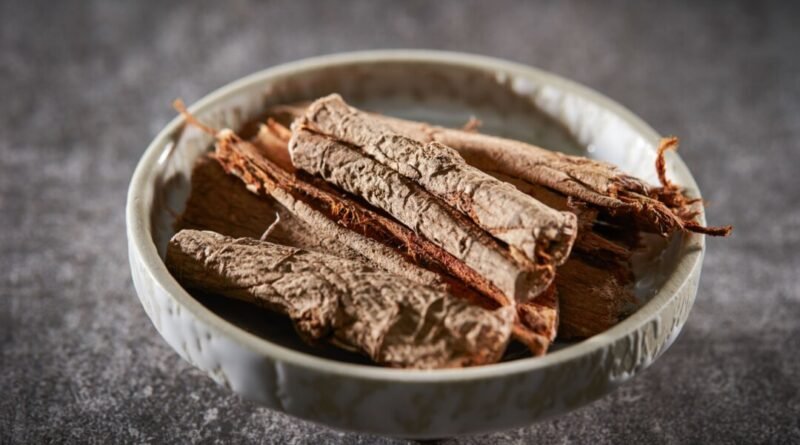Soothing Inflamed GI Tract with Slippery Elm Bark
Though the mechanism is poorly understood and clinical evidence is limited, historical medical books and modern herbalists highly recommend the herb.
Jessica Washington first learned about slippery elm bark when she was a patient dealing with symptoms of a Helicobacter pylori infection.
“I’ve always been more holistic-minded, but I was new to the world of stomach issues,” she told The Epoch Times. “Of course, I tried to learn as much as I could about slippery elm. Using herbs and plants as medicine is a really good way to support your body—possibly without running into side effects.”
Ms. Washington said slippery elm helped “take away some of the pain I was dealing with, and I think it helped with my healing. I felt like it was doing something good for my body.”
Coating the GI Tract
Often crushed into a powder, slippery elm soothes and moistens tissues with a viscous layer of mucilage when mixed with water and drunk. It’s considered anti-inflammatory, anti-diarrheal, antioxidant, laxative, and nutritive, according to the American Herbal Pharmacopoeia.
Demulcents prevent the caustic effects of irritants by coating the GI tract as they make their way through it, allowing people to tolerate eating without aggravating symptoms.
“The predominant utilization of slippery elm as a demulcent comes from extensive historical medical literature that supports its use for a wide range of internal applications where a soothing demulcent is indicated, in irritated and inflamed mucous membranes and tissues,” the American Herbal Pharmacopoeia’s article on slippery elm explained.
It added that medical literature supporting its use offers “many sources describing it as among the best and most versatile of mucilaginous agents.”
Where Does Slippery Elm Come From?
Slippery elm is a deciduous tree in North America—found mostly in the Midwest and eastern states, as well as in Canada. The bark—particularly the white inner bark—has been used therapeutically since the time of early settlers. It’s been consistently highly regarded.
One author in 1863 said “Various forms of slippery elm could be ‘found in every drug store.’” The bark can be chewed, used to make a tea, or ground into a fine powder to create a gelatinous drink or soup, or placed in a capsule.
Slippery elm has been used for a number of inflammatory and mucosal irritations involving the GI tract, as well as other organs, as noted in “The Physio-Medical Dispensatory” written by William Cook in 1869. Bark poultices were used both externally, for wounds and frostbite, and internally to treat diarrhea and dysentery.
“The Dispensatory of the United States of America,” originally published in 1833, described slippery elm as a demulcent and recommended it for dysentery, diarrhea, and diseases of the urinary passages. Slippery elm bark was commonly prepared as a drink and continues to be taken cool or warm.
Mechanism of Action
A few possible mechanisms that are at work in slippery elm may explain how it alleviates GI symptoms.
By coating irritated mucosa, slippery elm provides a protective layer in the GI tract. Additional indirect evidence suggests that it could interact with lymphoid tissue to modulate the immune system. Slippery elm’s antioxidant and anti-inflammatory properties may also impart changes within the mucosa itself.
Medical herbalist Richard Whelan explained on his website that watching slippery elm form a protective covering while healing wounds on the skin can give you an idea of how it works inside the body, too.
“Slippery Elm makes a wet, gooey, sticky mess if you dilute it and leave it to set and so, as it slowly slides down through the digestion on its way to being eliminated, it is able to make a gentle, soothing and effective bandage,” he wrote in a blog post that he shared with The Epoch Times.
“As soon as a person gets a significant inflammation in their gut lining, it physically changes the surface tissues to become rough, red and sore, rather like a graze. Slippery elm is able to stick to those sore parts, at least for a while, and so give the tissues a much-needed rest from further abrasion as material works its way through the digestive tract,” Mr. Whelan continued.
Recent research indicates that the bark appears to interact with human cells. The plant polysaccharides that constitute slippery elm may trigger complex interactions with local and systemic immune tissues, in addition to physicomechanical effects.
Modern-day Studies
More recent studies of slippery elm illustrate potential benefits with common chronic conditions of the modern era, however, research is far from complete.
The individual benefits of slippery elm, however, remain to be elucidated.
Scarcity of Slippery Elm
Despite its promise, herbalists may not always be eager to suggest slippery elm. Slippery elm is somewhat endangered because of a disease that’s been attacking elm trees, herbalist and author Rosalee de la Forêt told The Epoch Times.
“It’s important you get it from a place where it’s been cultivated,” she said. “We want to be careful with that plant and help it continue to thrive and not to overharvest it. Because of this, I often turn to marshmallow. It’s easy to grow and replenish in the garden, and it’s wonderfully demulcent. ”
Another demulcent herb that is similarly beneficial is licorice root, Ms. de la Forêt added. Aloe vera is also demulcent. Any of these options can soothe and cool the GI tract—a beneficial action for ulcers, ulcerative colitis, acute diarrhea, food poisoning, or intense feelings in the digestive system, she said.
“As much as there may well be other agents that could be beneficial that do not have the same issues of scarcity that we have with slippery elm, I just do not know anything that can help bandage an internal wound so quickly and effectively (in our own clinic we have found a supplier that certifies the herb is harvested sustainably),” Mr. Whelan noted.
Ms. Washington, who is now a functional diagnostic nutrition practitioner, said she also recommends it, particularly for clients who struggle with stomach pain or reflux. Anyone who is on prescription medications should also consult their doctor before taking slippery elm or other herbs.
“I am a big fan of slippery elm,” she said. “But aloe vera is another one of my favorites for stomach symptoms. It will calm down your GI tract and all that irritation.”




